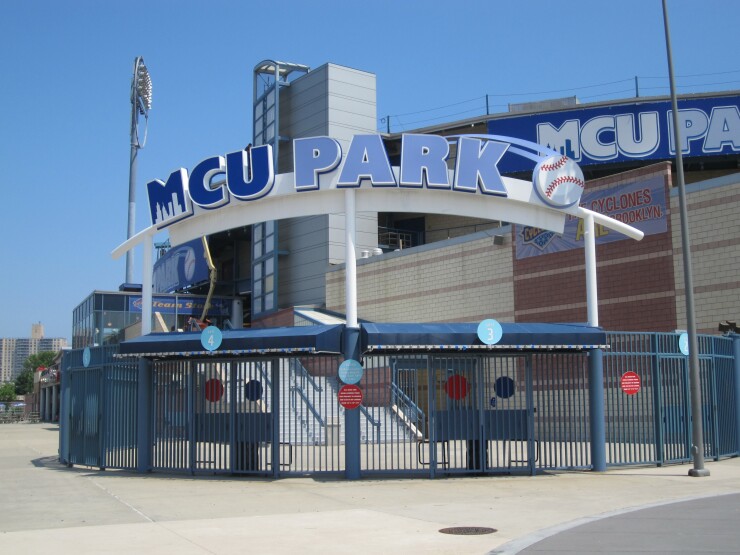Want unlimited access to top ideas and insights?
With the recent lawsuit between Michigan First Credit Union and the NBA’s Detroit Pistons likely
As the credit union movement has grown in recent decades, many CUs have stepped up to the plate to spread awareness by aligning themselves with various sports franchises at a variety of levels, from college to semi-pro, minor league and professional.
For example, the NBA’s Sacramento Kings play their home games at The Golden 1 Center, following a 2015 naming-rights deal with the $11.5 billion-asset credit union. Similarly, the Long Island Ducks, a minor league baseball club, play in Bethpage Ballpark, thanks to a naming rights deal with $7.9 billion-asset Bethpage Federal Credit Union. Other CUs have arrangements with local teams to promote their financial products by offering discounts to fans in order to attract them to join. And many CUs – some with more formal ties to schools than others – are official partners of college athletics, such as a recent deal from Georgia United CU, which saw the institution re-up its partnership as the official credit union of Georgia Tech athletics.
Worth the price tag?
But in the wake of the

Speaking before last week’s news of an appeals court lifting an injunction in that legal battle, Darrin C. Duber-Smith, senior lecturer at Metropolitan State University of Denver and an expert in sports marketing, said that for financial institutions, sports sponsorship deals are just one piece of an integrated marketing mix – but very important nonetheless.
“They can be very effective in improving brand recognition and their success can be measured and evaluated,” he said. “And successful relationships with sports clubs are long-running, as in many decades.”
Minor League Baseball’s A-League Brooklyn Cyclones, an affiliate of the New York Mets, play in MCU Park in Brooklyn, named such as part of a deal with $2.7 billion-asset Municipal Credit Union of New York.

“Our partnership with the Cyclones was our first sports partnership, and a key aspect of [this] was to build brand awareness,” explained Michael Mattone, VP of public relations at the credit union. “Additionally, that partnership allowed us to expand our branch network in Brooklyn, as we have a branch location right outside of MCU Park. And with MCU and Cyclones both focused on giving back to the youth of the community, we’ve partnered on Free Baseball Clinics for kids ages 7–14 for the past four years.”
MCU is also the official credit union of the NFL’s New York Jets, St. John's University Athletics and City University of New York Athletics Conference.

According to Mattone, the Jets partnership is primarily about branding, and represented a “great opportunity” for MCU to “align our brand with a highly visible and respected pro football team.” Furthermore, he said, the credit union was able to use data that showed MCU membership and civil service/uniformed service employment had a “high positive correlation” with Jets fandom in the New York area.
“Because of this and the great community work the Jets do, our partnership includes sponsorship of the Jets annual First Responders Game and presenting sponsorship of the Jets Tackle Bullying Initiative, a collaboration with STOMP Out Bullying that brings anti-bullying awareness and education to schools throughout the region,” Mattone added.
Mattone recommended that any credit union looking to entertain a sports partnership or naming rights deal should speak with their potential partner about joint community outreach, as “finding partner brands that are in alignment with your corporate social mission is highly important.”
Treat it like a media buy: Expert
Paul Lucas, a credit union marketing expert, said the best metrics to use when trying to determine the effectiveness of such sponsorships include tracking trends in membership growth, loan growth, percentage of members who have loans with the credit union and advertising cost as a percent of assets.
“Sponsorships should be evaluated as a media buy,” he said.
Lucas also noted that while it’s not possible to generalize about the effectiveness of sports sponsorships or naming deals, as a marketing consultant, he has come across many sponsorship deals that “used up dollars that would have created a lot more impact elsewhere.”
He cited a number of drawbacks from such sponsorships. For example, when a credit union offers “heavily discounted” tickets in batches to an athletic event, many, if not most, of the tickets in those packages will be wasted. “It takes a lot of time and effort to manage an ongoing, effective distribution of tickets,” he said. “Many tickets will go unused; and, of the tickets used, too many will end up being given to credit union employees within a day or two of the event. Even large corporations who do major sponsorships often end up wasting a lot of tickets.”
Lucas also noted that sponsorship deals should be managed at the highest level of marketing management; and a quarterly report should be provided to the CEO, summarizing the sponsorship activities and outcomes. “This is not a job for marketing manager or coordinator,” Lucas noted.
Lucas proposed that the sponsorship message should be incorporated throughout all ads and messages, with a logo in print messages and sponsor of tag in broadcast. “This seems like a no-brainer, but a lot of credit unions lack the expertise and manpower to manage sponsorships,” he commented.
Further, Duber-Smith also cautioned that such deals can be quite expensive – meaning, for credit unions, they are usually the exclusive reserve of the deep-pocketed, big institutions.
For example, he offered, if a financial institution has an annual $10 million sponsorship deal with a team, they would have to spend an additional $12 million annually in support of the agreement through various marketing campaigns – meaning, it’s actually a $22-million-per-year outlay.
Lucas similarly cautioned that credit unions should be careful when seeking sports sponsorship deals.
“If a new sports team enters the market or a new opportunity becomes available, it is worth evaluating,” he said. But Lucas was quick to add that sports sponsorships are not a proven marketing strategy for credit unions with assets under $1 billion. “It takes professional staff support to make a sponsorship pay off and smaller credit unions often do not have the manpower, expertise, or money to afford a significant sponsorship,” he said.





